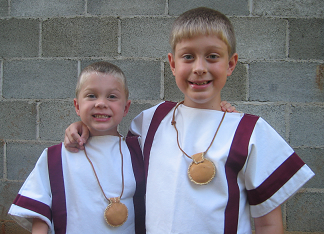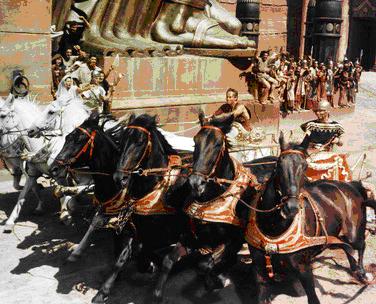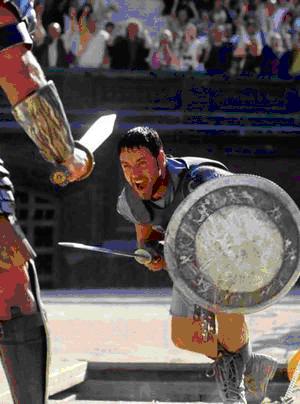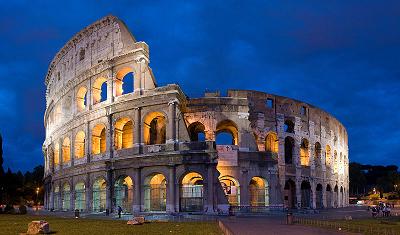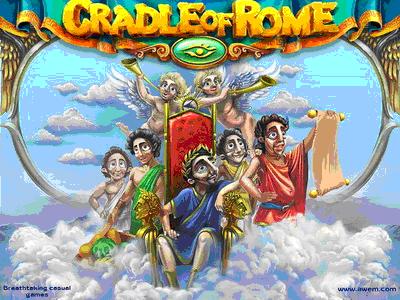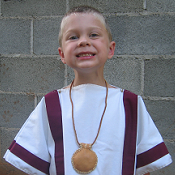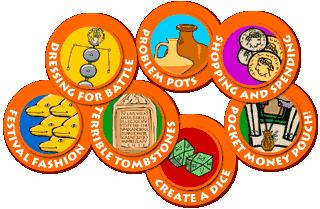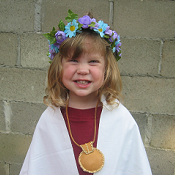Ludi Matutini 2761 AUC (Nova Roma)/Games for Children
THIS IS AN ARCHIVED PAGE DOCUMENTING THE INTERNAL HISTORY OF NOVA ROMA: LEARN MORE ABOUT ARCHIVED PAGES
Welcome to the Ludi Matutini for Kids!!!
Salve! (That's "hello" in Latin!)
Kids Games
Salve, I'm Lucius Vitellius Triarius the Younger!
Welcome to the Kids Games section of the Ludi!
I am presenting several good games for the bigger kids!!
Check out the games below, then play as long as you want!!!
Cradle of Rome is one of my favorites!!!!
Chariot Racing
The Hippodrome was an ancient Roman arena used to hold chariot racing. The most famous arena was the Circus Maximus, which was 600 meter's long and 200 meter's wide. It could hold up to 250,000 people (25% of the population of Rome). It was built into a hillside, and the material dug out was used as a support for the other side of the building. Seats ran in tiers around the u-shaped arena (except for the open end). A fence ran down the middle, called a Spine, and the chariots went around this.
Chariots were pulled by two or four horses, and were driven seven times around the ring at extremely fast speeds. Great skill was needed and sometimes accidents happened, drivers were also trampled to death on a regular basis. Big crowds turned out to watch the races. The racers were divided into teams, red, white, blue and green, and their fans wore these colours. Huge bets were placed on the races.
At one end of the track, there were boxes where the chariots waited. The judges sat above them and started the race by dropping a white handkerchief. There was a rope in front of the horses was lifted and the race began. The Emperor's palace was behind the Circus Maximus, and he had a special box where he could sit without even leaving the grounds of the palace. He attended most of the races that took place.
The races were an occasion to dress up. The ladies all dressed up in their best gowns, as did the men. People wore a lot of jewellery. Even the horses sometimes had pearls threaded into their manes and tails.
Even today, these arenas would be spectacular. Seating 250,000 people, it would be the biggest stadium in the world. Today the largest stadium can hold 120,000 people, so this shows how far advanced the Romans were two thousand years ago.
Gladiators in the Arena
Gladiators - Who Were They?
The word gladiator comes from the Latin for swordsman, from gladius, sword. That definition does not do justice to the life of that professional combatant. The first gladiators were part of a sacrificial rite adopted from the Etruscans. First introduced to Rome in 264 BC, the sons of Junius Brutus honored their father at his funeral by matching three pairs of gladiators. Gladitorial combat was originally part of a religious ceremony that was intended to insure that the dead would be accompanied to the "next world" by armed attendants and that the spirits of the dead would be appeased with this offering of blood.
Traditionally, this ritual was performed to honor important men. However, as the years passed, the ritual lost much of its religious significance. As this "sport" became more popular, Tertullian (born in Carthage, one of the greatest Western theologians) observed "this class of public entertainment has passed from being a compliment to the dead to being a compliment to the living." Aristocratic funerals became increasingly political acts where the living demonstrated their wealth, celebrated their victories and enhanced their reputations. Emperors presented the games to represent their power.
Gladiators were generally condemned criminals, prisoners of war or slaves bought for this purpose. Some free men entered this profession in hopes of popularity and patronage by wealthy citizens. The free men were often social outcasts, freed slaves or discharged soldiers. They volunteered to be gladiators and by the end of the Republic made up half the number of combatants. Gladiators were trained in combat at special, imperial schools.
The gladiators fought in various styles, depending on their background and training. Originally, as captured soldiers, they were made to fight with their own weapons and in their own style of combat. Because these soldiers were from other lands, their appearance was exotic and weapons distinct from those of the Romans.
In the first century AD, three of every five people did not survive to see their twentieth birthday and the odds of a professional gladiator surviving any one match was one in 10. Conversely, criminals who were to be publicly executed or Christian martyrs who refused to renounce their faith and worship the gods had no hope of survival in the arena. For it was the spectators who could spare the life of the loser with the wave of their handkerchiefs or the turn of their thumbs. This public spectacle would not be the place for the audience to show mercy to these gladiators.
Try our Gladiator game: Dress a gladiator for battle in the Roman arena. Your choice of weapons and armour will decide whether or not he is victorious. Will the emperor grant your gladiator his freedom, or will he fight badly and lose his honour?
A Day (or Days) at the Games
Gladitorial games were presented for ten to twelve days each year and often coincided with Saturnalia, a festival celebrating the god Saturn. (held around the time of the winter solstice with general feasting and revelry) Professional sign painters advertised with red lettered signs; heralds also proclaimed these spectacles. Programs were available to aid in the inevitable betting.
In the morning, battles between wild beasts would be presented. You might see bears fighting buffaloes, buffaloes against elephants, elephants against rhinoceros. Even the ostriches that were brought in to amuse the spectators were not spared. After dashing around the arena, they were killed by arrows from archers who were located in the stands. Fights between men and tame beasts were called , and were held to demonstrate man's power over even the strongest of beasts.
It is sad to note that the popularity of these spectacles led to the deaths of tens of thousands of animals. Entire species were no longer found in their native habitat, having been captured or driven away. Hippopotamuses were no longer seen in Egypt, elephants were not found in northern Africa and the population of lions disappeared from Assyria.
In the afternoon you would see gladiators appropriately paired; evenly matched, but not identical so there would be no competitive advantage. You might see retiarii, who were lightly armed, but mobile fight against the secutores or myrmillones , who were protected, but weighted down by their armor. This asymmetry was intriguing and demonstrates a sense of fairness that the spectators desired. Depending on the emperor of the day, you might see dwarfs fighting women, Amazons, or even senators and emperors. (note: Severus forbade female combatants in 200 AD- how civil!)
While Romans enjoyed going to the theater to see concerts and plays and to the stadium to watch chariot races, by far the most popular entertainment was to go the amphitheater to watch bloody battles. The most famous amphitheater was the Colosseum, the Flavian Amphitheatre which was built around 80 AD. It seated 50,000 people. The monumental size of this structure and its central location in the city speaks directly to the importance of this building and consequently this sport in the Roman Empire. Studies of Western civilizations show that where a society invests its money is where its priorities are. For four centuries, this bloody sport was entertainment for the masses.
A statesman of the day argued that these spectacles served a purpose beyond entertainment. Pliny the Elder said that viewing the games would inspire "a contempt for pain and death, since even slaves and criminals displayed a love of praise and desire for victory in the arena" Certainly, the games occupied the days of the citizens who would, therefore, not dwell on political unrest. This could explain how the games fulfilled political and social functions. Minus the extreme and final violence of death seen during these spectacles, we would be hard pressed to show how modern day sports such as professional hockey and football are much different than gladitorial games. The partisan support to our chosen teams demonstrates the enthusiasm some modern day citizens have towards their teams.
Just as gladitorial games lasted from dawn till dusk and over a period of many days- the current "March Madness" of the NCAA basketball tournament is no different. It is human nature to want to belong to some thing, to some team. Many of us who root for the Forty Niners should not be surprised to know that some of our ancestors were spectators at the games of their times.
Try this online puzzle of the Flavian Amphitheatre (or Colosseum) in Rome. It's not as easy as it looks!
Cradle of Rome
Imagine being given the chance to build Ancient Rome, the most legendary city of all time! One of the powerful capitals that have ever existed wants you to become its Emperor! You start at the beginning… First a village appears… Then you buy a fountain and a tavern… Will you choose the water mill or the blacksmith next? As you play more and earn enough money and supplies to buy larger buildings, watch your city grow INTO a vast and magnificent center of life, the heart of the antiquity! You'll be able to reconstruct masterpieces of Roman architecture, build the Coliseum to train gladiators, and even rebuild the Pantheon, the Temple of all the Roman Gods to bring you even greater luck! As you play and conquer addictive and intuitively designed puzzles and your city grows, the citizens who populate your city will proclaim you Emperor as a Head Priest considers a worthy tribute! Rise FROM an emerging ruler to the most powerful name to cross the mouths of both mortals and gods. Do this, and solve the puzzles that will be put before you, and you will enter Olympus - the Home of the gods! The fabulous lands of Caesar open their gates in front of you in the new puzzle game: Cradle of Rome!
Kids Activities
Salve, I'm Quintus Vitellius Triarius!
Welcome to the Kids Activities section of the Ludi!
I'm in charge of the Kids Activities section of the games!!
Explore the pages below or print them off and do the activities!!!
You can learn a lot about how kids and people lived in the old days!!!!
Kids Activity Printables
- CLICK HERE Roman Life I: Dressing for Battle
- CLICK HERE Roman Life II: Problem Pots
- CLICK HERE Roman Life III: Shopping and Spending
- CLICK HERE Roman Life IV: Festival Fashion
- CLICK HERE Roman Life V: Terrible Tombstones
- CLICK HERE Roman Life VI: Create Dice for Games
- CLICK HERE Roman Life VII: My Lucky Charm
Kids Picture Contest
A contest is being held for all Nova Roman Kids (12 and under). To participate, using MS Paint or another electronic drawing program, make a picture of a MORNING SUNRISE. You have to include the sun, but the rest is up to you. Clouds or no clouds? Blue skies or gray? Sunrise over land or water? Use your creativity to make the best picture you can to show what hapens at sunrise.
- Send completed picture to: lucius_vitellius_triarius@yahoo.com
- DEADLINE: All entries must be sent in by June 11th, 2008, in order to be reviewed and voted on by our judges.
- Entry emails (not pictures) must include your Roman name, your parent's Roman name, and your age.
- Pictures will be placed on line and judged by the Ludi Kids Staff and by the Citizens of Nova Roma.
DON'T HAVE A ROMAN NAME YET? That's okay, just use your Father or Mother's Roman name with "Minor" or "the Younger" on the end and you will have a Roman name for the picture contest entry!
Learn About the Ancient Romans and the Lands They Conquered
- You can find more things about the ancient Romans by CLICKING HERE.
- Visit the Romans in ancient Scotland by CLICKING HERE.
- Visit the Romans in ancient Greece by CLICKING HERE.
- Visit the Roman Baths at Aquae Sulis, Bath, England by CLICKING HERE
- Help the Roman Army build and Aqueduct to transport water from the mountains to the cities in the valley by CLICKING HERE.
Little Kids Games and Activities
Salve, I'm Tiberia Vitellia Triaria!
Welcome to the Little Kids Activities section of the Ludi!
I'm in charge of the Little Kids Activities section of the games!!
Parents can print the pages below for little ones to color. I love to color!!!
There are a lot of pictures about different things in ancient Rome!!!!
Little Kids Coloring Book Printables
- CLICK HERE TO VIEW/PRINT Ancient Roman Coloring Book for Kids
Roman Kids Online Movies
Historical Pages > Historical Pages
Master Index
Master Index
Master Index
Master Index > Maintenance Categories > Pages to be deleted > English > Nova Roma > Civic life (Nova Roma) > Events for Romans > Ludi (Nova Roma)
Master Index > Maintenance Categories > Pages to be deleted > English > Nova Roma > Nova Roma History
Master Index > Maintenance Categories > Pages to be deleted > English > Nova Roma > Res publica (Nova Roma) > Magistracies (Nova Roma) > Curule Aediles
Master Index > Maintenance Categories > Pages to be deleted > MMDCCLXI

